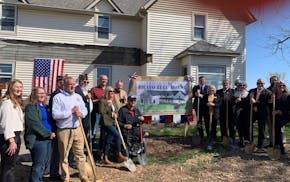One of the most notoriously confusing intersections in Minneapolis — where Cedar, Franklin, Minnehaha and 20th avenues collide in the Seward neighborhood — is likely to get improvements next year to ease congestion and improve safety.
It's all expected to happen when Hennepin County repaves a short but critical section of Franklin.
"It's a terrible intersection," said longtime Seward activist Sheldon Mains, a neighborhood leader involved in years of discussions of how to improve the tangled web of intersecting streets. "It's a really good first step."
The menu of small adjustments is aimed at improving safety for left-turning drivers, closing a short section of Minnehaha and diverting southbound truck traffic via a different route, along with promoting a little-used side road to encourage some drivers to avoid the junction altogether. There could also be pedestrian and cycling improvements as part of the entire $400,000 to $500,000 project.
Those changes would address an intersection that's drawn complaints since the 19th century when the problems involved streetcars and trains. Things didn't improve much after a 1950s effort at a fix created a complicated new weave of major streets.
That intersection ranked highest in the city for car-bike collisions for 10 straight years ending in 2010. A 2008 city pedestrian plan also rated it highly in need of improvements. An average of 20 car crashes happen there annually, nearly two a month.
"Statistically, this is way out there," said Bob Byers, a Hennepin County transportation engineer.
But getting to the point of making a fix has been difficult. Those who have been involved in previous efforts at improvements say some ideas proved too costly.
"This street project has expanded and collapsed under its own weight," said Andy Hestness, a project manager at Seward Redesign, a community development nonprofit.
One example came in 2010, when more than $800,000 in federal money for intersection improvements was turned back. One intersection solution that's been considered and rejected is a roundabout, which Byers said would cost tens of millions of dollars. One reason is the high cost of rerouting major electrical, gas and water lines that bisect the area.
So the trick became how to make improvements without breaking the budget. Medians to better channel traffic are proposed. So are changes to left turn lanes on Franklin at Cedar to align them so drivers can better view oncoming traffic. Left-turn signals are proposed, as well.
Neighborhood and business groups are reviewing the changes before public open houses later this fall. Those interested can learn more and sign up for updates here.
There still could be some pushback. The proposal would close a short stretch of Minnehaha just north of Franklin. That reduces the east-west crossing distance for pedestrians, but would complicate road access for a fast-food restaurant. A proposed lengthening of a median on Franklin near a fire station awaits that department's feedback.
New route for trucks
Some of the changes are possible because the city and Seward Redesign cooperated on a realignment of E. 22nd Street that connects it with Cedar. That provides a new route for trucks coming off Interstate 94 at Cedar to use 22nd and Minnehaha to reach the Seward industrial area farther south. The E. 22nd work was coordinated with Redesign's redevelopment of an old industrial site that is adding rental housing near the Blue Line station at Franklin.
Meanwhile, work is finishing on a renovation of the nearby Franklin median that's intended to enliven what's long been a bleak stretch under the light-rail station. That includes a performance area, space for food and art sales, seats and lighting. The city also plans to install protected bike lanes in several years along 20th.
A lot of complicating factors have long drawn complaints. One is that it is located near where the city's streets makes a transition from a grid dictated by the Mississippi River's bend to one set by the compass. Milwaukee Road tracks once cut diagonally across the original Cedar-Franklin intersection, meaning cars and streetcars were stopped 20 percent of the time by freight or passenger trains. After a decades long fight, a 1947 traffic study urged that Cedar's alignment be shifted more than a block east to pass under the Milwaukee tracks that now carry the Blue Line. Some neighborhood advocates hope future changes will help create more developable land and improve walking and bike access to the rail station and an adjoining bike trail.
"What they're proposing is not ideal. It's not everything that could be done. But it's what's in the budget," Mains said.
Steve Brandt • 612-673-4438
Twitter: @brandtstrib

Hennepin County Attorney inks contract with D.C. law firm to prosecute trooper Londregan case

Defense attorneys in Feeding Our Future trial cast doubt on FBI's meal fraud investigation

Protesters hold dueling Gaza rallies at University of Minnesota

Overdose deaths spike after incarceration, but Minnesota jails lack treatment

